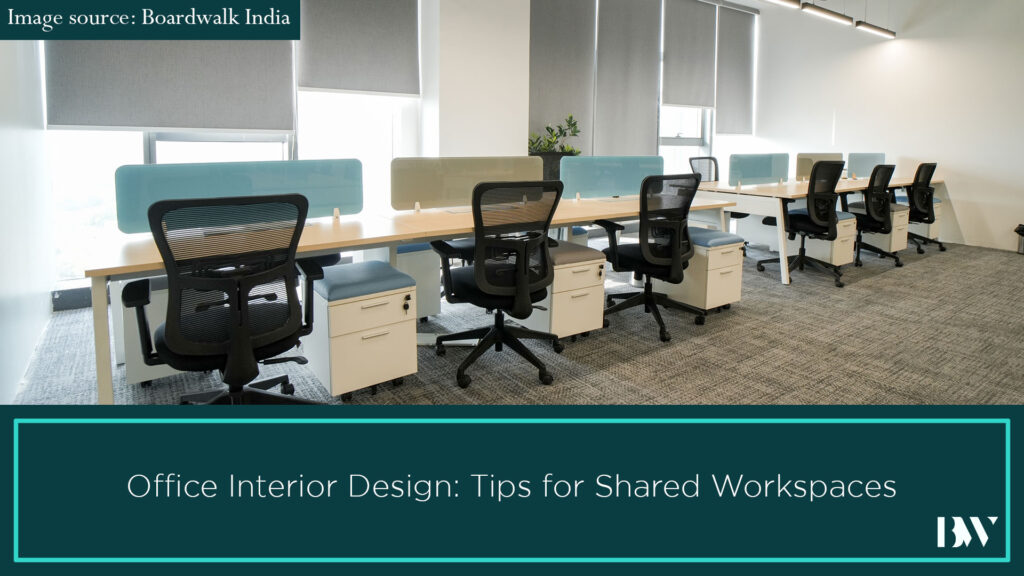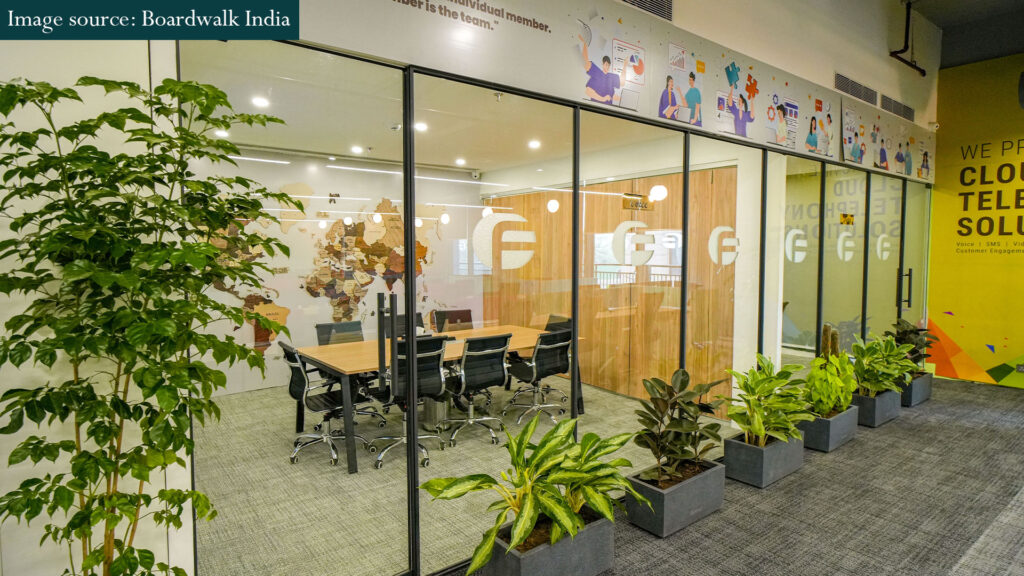Office Interior Design: Tips for Shared Workspaces

Do you need inspiration for workplace design ideas? This article looks at shared workspaces that can accommodate all of your needs related to teamwork and interior design.
Table of Contents:
- What are shared workspaces?
- Why are shared workspaces essential?
- Assembling the ideal combination of shared workspaces
- Types of shared workspaces
- Shared workspace interior design ideas for presentations
- Shared workspaces interior design ideas for cafes
- Shared workspaces interior design ideas for adaptable workspaces
- Shared workspaces interior design ideas for collision spots
- Interior design ideas for work lounges
- Interior design ideas for collaboration tables
- Shared workspaces for interior design ideas for project huddles
- Shared design ideas for interior design for booth seating
- Interior design ideas for meeting rooms
- Shared workspaces and interior design ideas for boardrooms

What are shared workspaces?
A room or section of a shared workspace where individuals may come together to solve problems, share ideas, and work toward shared objectives is called a collaboration space.
Why are shared workspaces essential?
Nowadays, the majority of knowledge work is built on teamwork. Consider these workers as individual athletes on a sports team; many of them are highly specialised. Together, they can tackle difficult challenges with many moving pieces; alone, they won’t accomplish anything.
The shared workspace still has a role, even though it has evolved. Because of this, businesses are making a lot of effort to get employees back into their premises, which promotes face-to-face interactions that lead to increased innovation.
Assembling the ideal combination of shared workspaces
There is definitely a pace to working together. There is great benefit in being together. Having the time to discuss ideas privately or in smaller groups is also essential, though.
In actuality, one of the most frequent grievances is distraction. Staff satisfaction will increase if rooms intended for intense concentration and lively collaboration are balanced well.
Everything is up to choice, and not all teamwork is created equal. Enough variety makes it easier for people to locate a collaborative environment that works for them.
Types of shared workspaces
Seldom do companies require their workplace to resemble a sea of desks. In light of this, the majority ought to be investigating ways to assist individuals in making the most of their time at work. In order to achieve that, we’ve compiled the top cooperative work areas from our most recent projects:
Outdoors
It’s common knowledge that being outside improves focus and lowers stress hormone levels. It’s a great choice for business meetings as well.
Therefore, take a walk if a good location isn’t available.
Shared workspace interior design ideas for presentations
You can pique the interest of your audience in these dramatic settings. The best stage to engage people is a circular one. Furthermore, this shape fosters greater intimacy, which facilitates idea sharing.
If not, the form is frequently determined by technology. Choose a more conventional arrangement where the audience faces the presenter if slides are necessary.
Make sure the seating in both is adjustable so that more people can fit in as needed.
Shared workspaces interior design ideas for cafes
These areas could be argued to be more about community than teamwork. However, as you enter a bustling cafe and feel the energy inside, you realise that these are the cornerstones of stronger interpersonal bonds.
Regardless of size, the goal of these areas should be to foster community. to catch up, get together for an occasion, or hold spontaneous gatherings.
Shared workspaces interior design ideas for adaptable workspaces
Without having to start from scratch, teams can choose the structure that best suits their needs.
Shared workspaces interior design ideas for collision spots
If you’re looking for office design inspiration for those “water cooler” moments, pinpoint key locations along important routes to create intimate gathering areas. For instance, place chairs between the cafe and the open office.
Actually, collision spots are a cheap and effective approach to provide more opportunities for collaboration because circulation takes up a lot of space. Connecting levels, teams, and individuals is another excellent use of staircases.
Interior design ideas for work lounges
The centre of any house is the lounge. Loved for its cosiness and capacity to calm people down. It’s a multipurpose area at a workplace where you can relax and catch up during the day. Perfect for unscheduled periods and for arranging informal meetings.
Consider how these areas can benefit other adjacent settings when incorporating them into a shared workspace. Workstations and other concentrated areas can be divided to create rhythm in the design of the shared workspace. Additionally, consider a range of accessories, textures, and heights.
Interior design ideas for collaboration tables
A separate room isn’t always necessary because this kind of table works well in other settings. People can leave their desks, come together for a short while, and then return to work if a collaboration table is incorporated into the open workspace.
Collaboration tables are also a great way to extend a teapoint and give the area a dual purpose. The table is for socialising during lunch. It is then used for meetings for the remainder of the day.
Shared workspaces for interior design ideas for project huddles
Project huddles are designated spaces where teams can discuss ideas and reach decisions quickly. They are usually semi-enclosed and may accommodate two to ten people.
Project huddle supplies also include flipcharts, post-it notes, and whiteboards. Their AV technology is integrated, so it’s easy to accommodate remote workers. Think about utilising digital whiteboards in this situation so that everyone may participate.
Shared design ideas for interior design for booth seating
Booth seating is an excellent setting for group work. People feel inherently protected when they are enclosed, whether fully or partially. They feel more comfortable and are inspired to share ideas in this environment.
Furthermore, booths serve a variety of purposes. They work well for focused collaboration, one-on-one discussions, or heads-down work.
Interior design ideas for meeting rooms
The traditional location for collaboration is a meeting room. They continue to be a mainstay of any space combination, with privacy, tech, and ergonomics as their key priorities.
When choosing shared workspaces and interior design ideas, take into account how formal the space should feel and use finishes and artwork to reflect that.
Your provided AV gear is necessary for both in-person and remote cooperation. Increase the airflow to ensure that people are getting enough fresh air to help them be productive. Finally, provide scene and temperature settings so that users can adjust things to suit their comfort levels.
Shared workspaces and interior design ideas for boardrooms
The goal of these rooms is to maximise impact. Large gatherings of your most important guests are hosted in boardrooms, therefore comfort, design, and specification are crucial factors to take into account. Remote collaborators can interact as though they are in the same room thanks to seamless technology.
When creating boardrooms for shared workspaces or interior design ideas, take into account how vertical and folding walls connect to the surrounding area. By doing this, the zones become more functional and ideal for breakout sessions and events.
Make sure these areas are receiving enough fresh air. People who spend a lot of time in conference rooms experience higher CO2 levels, which makes them feel exhausted. People with fresher air have more energy.
Chillout zones
Ultimately, when it’s time for a break, we all need a tranquil haven to retire to. This room, which is situated far from the busiest parts of the business, prioritises mental wellness.
A calm ambiance is produced by soft finishes along with low lighting. Give attention to the acoustics. Finally, decide if you want to provide media and music or be tech-free. Make sure everyone is feeling rejuvenated, reenergized, and prepared to work together once more.
Conclusion
In conclusion, variation is a key component of our interior design concepts for collaborative workspaces. There is no one ideal way to collaborate; rather, it is about having enough options to choose the ideal setting.
For more information on Interior Design Tips for Shared Office Workspaces, visit us at www.boardwalkindia.com
